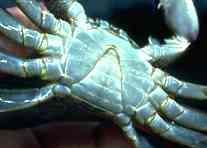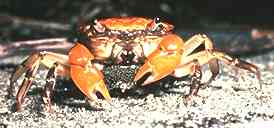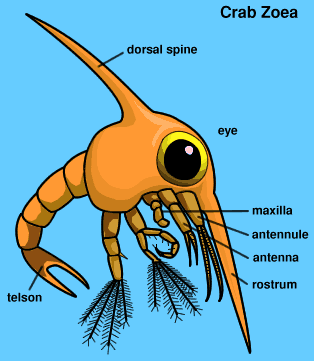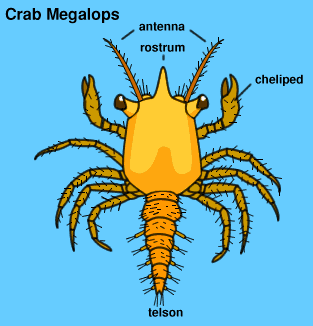|
|
Decapod Crabs
Reproduction and Development
Decapod crabs are built like a folded-up lobster. The abdomen, which is equivalent to a tail, is folded up tightly underneath its body to form an abdominal flap.
 When
you turn a crab over and look underneath, you can tell a crab's sex by
looking at its abdominal flap. A male crab has a small triangular flap,
while a female crab has a broad oval-shaped abdominal flap.
When
you turn a crab over and look underneath, you can tell a crab's sex by
looking at its abdominal flap. A male crab has a small triangular flap,
while a female crab has a broad oval-shaped abdominal flap.
When a male and female crab mate, many female decapod crabs can store the male sperm until her eggs are ready to be released. When the eggs are released, the stored sperm flows over them and they become fertilised.
 The
female crab holds the fertilised eggs in a big spongy mass between its
abdominal flap and the body. The eggs are cemented to the pleopods, which
are small legs, creating the "berried" appearance.
The
female crab holds the fertilised eggs in a big spongy mass between its
abdominal flap and the body. The eggs are cemented to the pleopods, which
are small legs, creating the "berried" appearance.
To keep the eggs healthy, the female crab continually "waves" water over the eggs with the pleopods.
When the eggs hatch into zoea larvae, they drift away in the ocean currents as plankton. As the juvenile crab grows in size, it goes through a series of moults, each larval stage changing form and function as it grows in a process called metamorphosis.
At each moult more segments are added to the end (posterior), and the feathered limbs are replaced by the clawed limbs. The megalops stage more closely resembles the adult decapod crab.
Crabs
Tubercled
Crab
Reef Crab
Smooth-handed Crab
Variegated
Shore Crab
Red Bait Crab
Sowrie Crab
Mudflat Sentinal Crab
Smooth Shore Crab
Seaweed-decorator
Crab
Crab
reproduction
Crab parasitism
Home
Page
Taxonomy
Biogeography
Rocky Shores
Tidal Levels
Intertidal Zonation
Environmental Factors
Biological
Factors
Feeding Relationships
Activities
Glossary
References
 Life
on Australian Seashores
Life
on Australian Seashores
by Keith Davey (C) 2000
Learning Consultant
- Media
The University of Newcastle
email at australian_seashores@hotmail.com
Scientific Consultant: Phil
Colman
site created 01.01.98 : updated 01.04.2000


